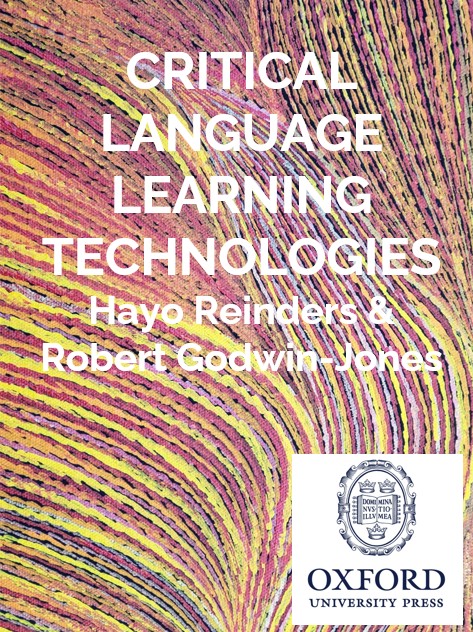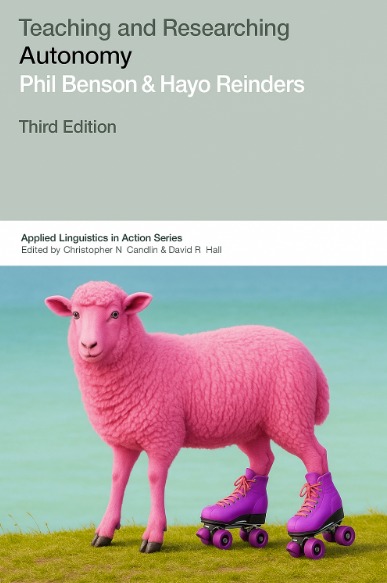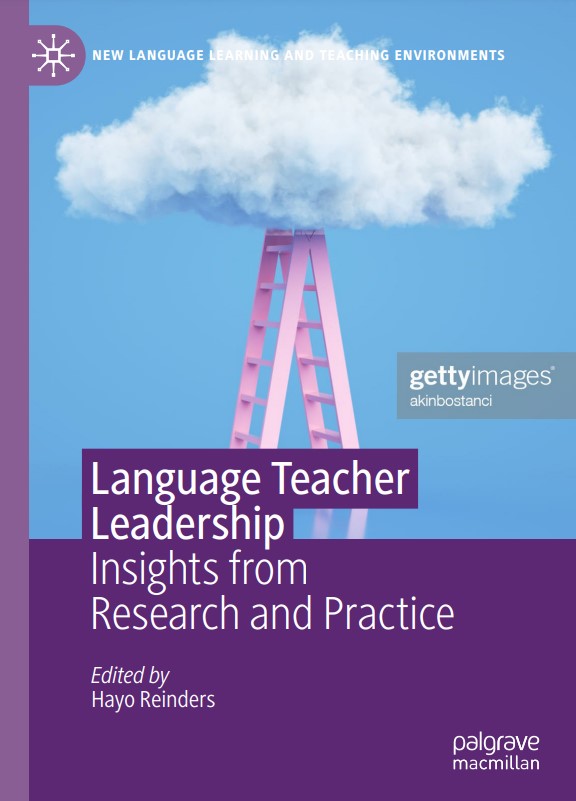Books > Strategies
Cotterall, S. & Reinders, H. (2004). Learner strategies: A guide for teachers. RELC.
Portuguese and Spanish translations are available.

Below you can find a sample chapter. You can also download a sample of the book here.
Learner Strategies
A Guide For Teachers
How Do I Teach
Strategies?
In the last chapter we talked about how you can prepare your students for strategy instruction. In the first part of this chapter we suggest a procedure for showing your students how to use new strategies. In the second part of the chapter we suggest some ways you can find out what your students know about strategies, and which ones they use.
OVERVIEW OF THE PROCEDURE
There are five key steps in teaching new strategies
to language students:
• Raise awareness of the strategy
• Model the strategy
• Try out the strategy
• Evaluate the strategy
• Encourage transfer of the strategy to new contexts
We explain the strategy instruction procedure below in detail, using the cognitive strategy of summarising when reading as the target strategy. We have chosen this strategy because it is easy to demonstrate and should produce immediate benefits for students when they are reading a wide range of different texts.
1. Raise Awareness
The first step in teaching students a new strategy is showing them how useful it can be. One way of doing this is by relating it to a problem which it can help solve. Let us say you have decided to introduce summarising to your students. Start by asking them how they normally read long texts that are difficult to understand. After listening to what they typically do, you could explain that good readers summarise the text in their heads as they read. Tell your students that you will show them what this means. The aim of the discussion is to raise interest in the strategy and to
persuade your students that it can help them. At this stage it is also important to name the strategy and explain what it involves. The strategy of summarising is usually described as “saying or writing the main idea”.
One important decision you need to make early on is what terminology you will use to describe the strategies that you introduce to your students. Your decision will depend on the age of your students, their level of proficiency in the target language and the number of times that you intend to refer to that strategy, amongst other things. Some teachers like to ask their students to name the strategies for themselves. This can make the strategies more accessible and adds an element of fun. You may also want to consider using the students’ first language to talk about the strategies, if that is an option for you. If this makes it easier for the students to understand the purpose and benefits of the strategies, then it is definitely a good idea.
A number of different tasks can be used to raise students’ awareness of strategies. While discussion is usually the most popular option, you can also ask students to interview each other about their experience with strategies, invite experienced language students to talk about their strategy use, or produce reading or listening tasks based on ideas presented in teacher guides (e.g. Chamot & O’Malley, 1994).
Task 5.1
Awareness Raising
Think about your students. What strategy will you focus on in your first strategy instruction session? Think about how soon the students will be able to use the new strategy in their learning, how easy it is to demonstrate, and how widely it can be applied in different subject areas.
2. Model the Strategy
The next step involves showing the students how to use the strategy as you read the text together. The basic procedure you use here is a “think aloud”. When you “think aloud”, you say out loud what thoughts are going through your head as you use the strategy. With summarising, this helps students see, for example, how “clues” in the text help good readers distinguish between main ideas and details. Your aim in modelling the strategy is to show your students how summarising helps you build up a picture of the text in your head, and helps you understand the next section of the text. During the think-aloud, ask yourself questions like “So what is that sentence telling me?”, and answer them out loud e.g. “It’s giving an example of the point made in the previous sentence.” This helps your students know what you expect them to do when it is their turn to try out the strategy.
The good thing about modelling is that it helps students “see” learning processes which are normally invisible. For example, in the case of summarising, often poor readers simply don’t know how to turn the words on the page into a main idea statement. However by watching you construct your summary as you read, they see for themselves how the information in the text contains meaning, and how each sentence adds to that meaning. By modelling strategies, the “secrets” of successful students can be shared with the less successful ones.
You will also need to put some time into choosing an appropriate text to use for the strategy instruction session. You want to be able to model the strategy on the text without the students spending too much time making sense of it. They will then continue reading the same text when it is their turn to try out the strategy.
Task 5.2
Think Aloud
Practise doing a “think aloud” with the paragraph you have just read. First re-read the paragraph. Then, stop and ask yourself out loud “What was that paragraph all about?” What was the main idea that it discussed? How did it explain that idea? What kinds of details did it include? How would I finish the sentence – “This paragraph explains how …”
1. Try out the Strategy
Now it is time for the students to try out the strategy for themselves. During this stage, they need to be able to get help at any stage, and to receive feedback on what they are doing. This might mean that you want to ask a colleague to help out in your classroom to share the load. Their first experience of using the strategy must be successful. Design the activity so that your students begin using the strategy gradually. For example, after modelling the strategy to the whole class for several paragraphs of text, you could ask for a volunteer to produce a summary of the next section of text. As a class, you could then listen to the volunteer’s summary, and ask questions about how the produced it. Next, you could ask the students to work in groups, taking turns to try out the summary strategy on a paragraph of text each. When you introduce a strategy for the first time, make sure that each student gets plenty of practice using it. This has implications for timing. Students need to finish the strategy session feeling confident that they know how, when and why to use the strategy. You can encourage extra practice by giving students “take-home” tasks. Ideally, strategies should become part of normal class discussion.
2. Evaluate the Strategy
The fourth step in the instruction procedure is the most important one. After introducing a new strategy to your students, you need to ask them how useful they found it, and how easy it was for them to use. Encourage your students to report honestly on their experience, and don’t force them to keep using any strategy they find unhelpful. Some strategies will be more helpful to some students than others. Therefore you need to present a wide range of strategies and also ask students to share their own successful strategies. This will mean that your strategy programme has something to offer everyone.
One of the goals of the evaluation stage is to find out what difficulties your students experienced when they were using the strategy, and to provide help. Often students follow the wrong steps in using the new strategy at first, or find that it is too difficult to use on their own. This is normal. Therefore you need to plan additional opportunities for your students to try out each new strategy. If you provide enough strategy practice and the right kind of support, your students will gradually become more efficient and confident at using the new strategies.
Task 5.3
Evaluating the Strategy
What is the best way of getting your students to evaluate the new strategies you present? Will they be more honest if they can talk in groups first and then report back? Will the discussion be better if they have time to think or write some comments first? Brainstorm a list of possible methods and then rank them in terms of appropriateness.
5. Encourage Transfer of the Strategy to New Contexts
If you want your students to become confident at using particular strategies, you need to encourage them to use them in new situations. In order for students to do this, they need two things: firstly, the chance to reflect on the value of strategies in learning, and secondly
– opportunities to use the new strategy.
A key element of successful strategy instruction is a continued focus over time. Students cannot be expected to start using new strategies after meeting them only once. Therefore it is better to introduce a small number of strategies to your students and provide regular practice opportunities with them, than to introduce a larger number of strategies in one session without providing follow-up practice.
If your students are successful when they try new strategies, this will motivate them to use those strategies again in the future. But this should not be left to chance. You need to develop a plan which identifies which strategies you will introduce, and how and when you will provide further practice with each one.
However, in addition to ongoing opportunities to use their new strategies, students also need the chance to develop their knowledge about strategies. Students can only transfer learning to new contexts if they understand and can manage their learning. You can help learners gain control of their learning by providing practice opportunities. But if students are to understand the strategies they use, you need to create opportunities for them to develop their understanding. One good way of doing this is to ask your students to write in a journal what they know about strategies, and which ones they find most useful. Another simple way of getting students thinking about strategies is to ask them to design posters or cartoons to “advertise” their favourite strategies. They can then be asked to “sell” their strategy to their classmates.
ASSESSING STRATEGY KNOWLEDGE AND SKILLS
Once you have begun introducing new strategies to your students, it is a good idea to spend some time regularly checking what your students know and can do. It is possible that your students’ knowledge and skills may develop at different rates; in other words, they may be able to explain quite well what a particular strategy is, but not be able to use it. Therefore, you may have to use different methods to get a good picture of what your students know and can do.
In the previous section we mentioned several ways of obtaining information about students’ use of strategies, such as keeping a journal, interviewing each other and discussing strategies. In chapter
4 we looked at questionnaires and interviews as ways of finding out what your students already know about strategies. These methods can also be used to find out what your students have learned about strategies. Each of these methods will give you a different type of information. Here are some points to consider:
• Questionnaires may tell you what students know about strategies and how they think they use them, but they may not tell you much about what your students actually do! Be aware that questionnaires are generally easy to administer but may take a long time to develop.
• Interviews can give you very useful information about why students use or don’t use strategies. But, interviews can take a long time to conduct and even more time to analyse, especially if you want to transcribe them.
• Discussions are an easy, informal alternative to interviews and often form part of your normal classroom activities. However, you will probably not obtain much information about individual students from a discussion. Discussions are more useful for getting a general idea of how the class is finding the strategy work.
• Observations can give you a good idea of which strategies students use, especially in tasks which involve communication. Observations can also show you how successfully a particular strategy was used. However, observations can be very time- consuming and are less useful at providing information on cognitive strategies such as inferencing which occur inside the student’s head!
• Think-aloud tasks, where the learner verbalises what (s)he is doing, can give a lot of information about how a learner approaches a task and what strategies (s)he uses. However, a think-aloud task can be time-consuming, and is probably not a very natural thing to ask students to do.
• Finally, you can use journals or logs. Many teachers use these as part of classroom teaching; they can be a great source for reflection, motivation, and discussion. They can also be used to record strategy use. Below we discuss this further.
There are many other ways in which strategies have been assessed by researchers, such as with the help of computer programmes and by doing extensive analyses of learning behaviour. However these methods are not likely to be of great relevance to busy teachers.
If you decide to use a strategies journal or log with your students, you can organise it in many different ways. Students probably need to be aware of the different types of strategies (metacognitive, cognitive and social/affective), so you could suggest that they have different sections in their journal for strategies of each type – using whatever names they choose. You could also ask your students to keep a record of the different tasks they use particular strategies for, and to evaluate the effectiveness of the strategy for doing that task. Also get them to write about their difficulties. By using a journal like this, students can gradually increase their knowledge of specific strategies.
Task 5.4
Which method?
Look at the list of methods (above) for assessing strategies. What do you want to find out about your students? Do you want to find out what they know about strategies or which strategies they can use ? Or do you want to find out why they use some strategies and not others? Also look at the practical points noted about each method. Which method would suit you best?
This chapter has presented a five-step procedure for introducing strategies to your students. A focus on strategies emphasises the process of learning and using the language more than the outcome of individual tasks. This emphasis should help focus students’ attention on how they can find the best “match” between strategies and language tasks. In the final chapter, we discuss materials which can be used for teaching strategies.


